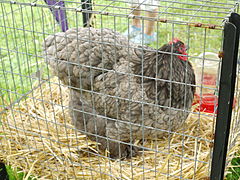Cochin chicken
Livestock Conservancy (2020): recovering[2] | |
| Country of origin | China |
|---|---|
| Use | ornamental |
| Traits | |
| Weight | |
| Egg colour | brown |
| Comb type | single |
| Classification | |
| APA | Asiatic[5]: 12 |
| ABA | Feather legged[5]: 8 |
| EE | yes[6] |
| PCGB | Soft feather: heavy[7] |

The Cochin is a breed of large domestic chicken. It derives from large feather-legged chickens brought from China to Europe and North America in the 1840s and 1850s. It is reared principally for exhibition. It was formerly known as Cochin-China.
History
Like the
The Cochin was included in the first edition of the
The Cochin, both full-sized and bantam, was included in the first edition of the
Characteristics
The most distinctive feature of the Cochin is the excessive plumage that covers leg and foot. The skin beneath the feathers is yellow.
In the United Kingdom the recognised
Use
The Cochin has been bred principally for exhibition, at the expense of productive characteristics.[3]: 89 It is a good layer of very large tinted eggs, and lays well in winter.[3]: 89 [8] The hens are good sitters and good mothers, and may be used to hatch the eggs of turkeys and ducks.[8] The meat tends to be coarse in texture and excessively dark; capons slaughtered at an age of 12–16 months provide a good large table bird.[8]
Gallery
-
Blue Cochin hen
-
Cochin Bantam cock
References
- ISBN 9789251057629. Accessed January 2017.
- ^ Heritage Poultry Breeds: Chickens. Pittsboro, North Carolina: The Livestock Conservancy. Accessed July 2020.
- ^ ISBN 9781405156424.
- ^ ISBN 9781580176675.
- ^ a b c d e APA Recognized Breeds and Varieties: As of January 1, 2012. American Poultry Association. Archived 4 November 2017.
- ^ a b Liste des races et variétés homologuée dans les pays EE (28.04.2013). Entente Européenne d’Aviculture et de Cuniculture. Archived 16 June 2013.
- ^ Breed Classification. Poultry Club of Great Britain. Archived 12 June 2018.
- ^ a b c d e Cochin Chicken The Livestock Conservancy. Archived 3 October 2016.
- ISBN 978-0-8203-2213-1.
- ^ a b William Bernhard Tegetmeier (editor) (1865). The Standard of Excellence in Exhibition Poultry, authorized by the Poultry Club. London: Groombridge and Sons, for the Poultry Club.


